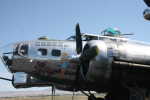Rare Flying Fortress delights crowds at airport

For some, the opportunity to see the rare flying B-17 bomber that flew into Mountain Home last weekend was a chance to connect with a piece of WWII history.
For others, it was a chance to recall history.
"We do it for the veterans, to show people what they had to do in WWII," said Jay Gates, one of the pilots of the Flying Fortress," Sentimental Journey."
"Wherever we go," pilot Jim Kimmel added, "we run into vets who flew in these planes. Sometimes they tell us stories of their missions. Sometimes they'll just sit in their old crew stations for up to an hour, saying nothing, but you can see tears in their eyes."
The B-17 Flying Fortress was the mainstay of the allied daylight bombing offensive in WWII. Crews were rotated back to the states after 25 missions, but very few made it beyond 12 missions in the early years of the war. It was a highly dangerous job that cost 35,000 lives in the European campaign alone.
"Sentimenal Journey" had been restored by a non-profit group of volunteers, the Commemorative Air Force (formerly known as the Confederate Air Force), and each year the aircraft and its crews tour the country offering tours of the plane and rides, one of less than a dozen still flying in the world.
It takes special training to fly the plane. Not only does a pilot need to be certified for multiple engines to fly the four-engine bomber, but they also have to have the much rarer tail-wheel certification. But for both Gates and Kimmell and the other members of the crew, it is a labor of love to bring the sacrifices of those who flew in planes during WWII home to the crowds that show up at each stop.
"Sentimental Journey" wasn't originally scheduled to arrive in Mountain Home. After making a stop in McCall, it was supposed to go to Twin Falls, and then on to Logan, Utah. But a runway resurfacing project in Twin Falls forced cancellation of that flight, and they decided to bring the plane to Mountain Home, instead, with only about two weeks notice to draw any crowds.
But the crowds did come, in small groups of about 20 people at any given time during the three days the plane visited Mountain Home Municipal airport.
Some were simply history or aircraft buffs who wanted to see the great silver plane of legend and lore. Others, like Bob Hoover of Mountain Home, were there to recall his days as a belly turret gunner on the bomber, one of the most dangerous positions in the cramped and crowded aircraft.
"The last time I saw one," he said, "was 1965. I'm looking forward to flying it again."
For Michael Low, who flew in the very front of the plane, sitting in the plexiglass bubble of the bombadier's seat just behind an authentic Norden bombsight, "it was really a trip, especially as you sped down the runway. I've flown in a lot of planes, but I have admit, I couldn't sleep last night. I was like a kid going to Disneyland."
For Bud Adams, it was a chance to connect with the history of his family. His late father flew as a waist gunner in B-17s during WWII, and that was the position he took on his ride, standing behind the .50-caliber machine gun used to fight off enemy fighters.
"My dad didn't talk much about it, and I didn't ask," he said. But standing there, where his father had fought in the air war, "was very emotional. You get an appreciation for what they went through."
For Ethan Lang, a music teacher in the Mountain Home School District and a military history buff, his ride also was an emotional memory.
As Lang climbed into the Navigator's position, he clutched an American flag to his chest. His grandmother's brother had been killed in WWII when his B-17 was shot down, and the flag was the presentation flag given to his family. His grandmother, Myra Lane of Indianapolis, Ind., has flown that flag almost every day since the services for her brother, Lang said, and it was a very special thing for him to fly that flag aboard "Sentimental Journey," before he returns it to his grandmother.
"You read about what they did in books, and you watch (the footage from WWII) on TV, but nothing really compares to sitting up there in the crew seats, smelling (the fumes from the engines) and hearing the engines' roar. It's a whole new level of history appreciation."
More photos available in the Mountain Home News Photo Gallery.
